|
FAQs on Bryozoans
Related Articles: Bryozoans,
Related FAQs:
Reteporellina graeffei
|
MD.JPG)
|
|
Re: Bryozoa pix /Bob Fenner 11/18/15
The first 3 pics without a doubt are Bryozoans.
I got another reply from Jane. If Kevin says not a Bryozoans but sponge it is a
sponge. She added after I sent another reply, which had her in doubt, was the
"vivid color and sparky like appearance but the canals really do look sponge." I
sent her another pic of a sponge ID to exact species that looks like yours but
without the vivid color and sparkly look. She said
that vividness and sparkly look is rather odd for a sponge but must be one.
She is going to send it to another Bryozoan tax she knows. No word yet from Les
yet.
I can't count the times we as hobbyists, to include Taxonomist, are stumped and
we get things wrong, where you would think they were easy. And most often it is
Worms, Bryozoans, Sponges and Ascidians. And by far sponges being called
ascidians or vice- versa. And then there are all those ID books and websites
with wrong ID, were at times the pic has the wrong
caption, a editing error. Then there are these divers coming up with the most
bizarre <schist> you have ever seen, often never ID by anyone. It is like
WTF is that.
Boomer.
<Ahh; thanks to all for your efforts. Bob Fenner>
|
%20sm.JPG)
%20sm.JPG)
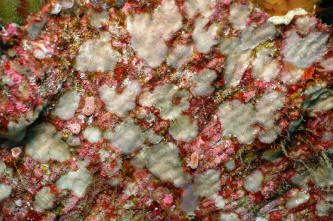
.JPG) |
|
LR ID, illiterati 8/18/12
hi found this thing stuck fast under a rock, it was found next to a smaller
one. The big one is about 25mm long and about 10mm thick any ideas on what
it is
<Maybe a Bryozoan of some sort. Bob Fenner>
|
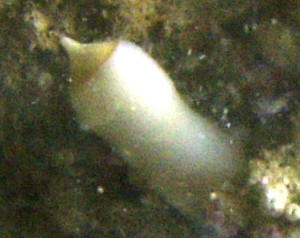 |
|
Bryozoan or Sponge? Please ID 4/30/12
Hi Crew...
<Hi, Gretchen, Felicia here> Could this be some type of sponge? <My first
reaction to the photo was that it is a Bryozoan. Could be a type of sponge,
though.> It seems to have grown rather quickly. If it's not a sponge, is it
safe or should I
kill it? <Whether it's sponge or Bryozoan, it's not a threat to your
livestock. I would keep it!> It's actually rather pretty.
http://i722.photobucket.com/albums/ww227/wontonflip/125gallon/DSC00694.jpg
Tank is a 125g FOWLR (ok, except for some mushrooms that hitchhiked on the
rock), and it's been up for 3 years. Thanks! Gretchen
Re: Bryozoans 5/1/12
Thanks Felicia! Looked it up, and you're right, it
might be a Bryozoan. I poked it and it had a hard shell :) <Glad
to be of service, Gretchen. Thank you for the picture; these are lovely
animals. You may wish to read
http://www.wetwebmedia.com/bryozoanfaqs.htm to further satisfy
your curiosity. Enjoy!> -G-
Please identify this white growth
5/1/12
Hi Crew...
<Gretchen>
Could this be some type of sponge? It seems to have grown rather
quickly.
If it's not a sponge, is it safe or should I kill it? It's actually
rather pretty.
http://i722.photobucket.com/albums/ww227/wontonflip/125gallon/DSC00694.jpg
Tank is a 125g FOWLR (ok, except for some mushrooms that hitchhiked on the
rock), and it's been up for 3 years.
Thanks!
Gretchen
<Mmm, likely some sort of Bryozoan... see here:
http://wetwebmedia.com/bryozoans.htm
the linked files above. Bob Fenner>
|
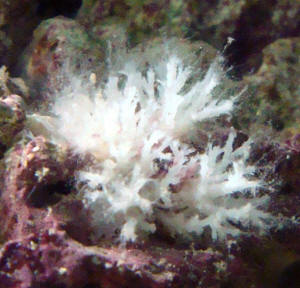 |
ID Please?... Bryozoan 10/27/07 Hi crew,
<Hi Deryck, Mich here.> Love your hard work. <On behalf of
Bob and the crew, we thank you.> Wondering if you might be able
to identify the white bits growing under some of my live rock?
<ScottF and I think it's a Bryozoan... though a sponge may
also be a possibility, but leaning more towards a Bryozoan.> You
guys/girls do a great job, thanks for any help you can provide!
<Thank you for your compliments they are indeed appreciated.
Sincerely Mich.>
Deryck |
|
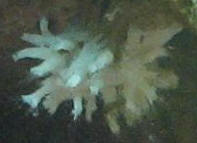
|
Ye Ole Trees... Bryozoans 7/10/07 Hello
Crew, <Hello Chris, Mich here.> Just wanted to make sure none
of the attached are a problem. <Mmm, nope. No problems that I
see.> My feather duster has been emitting some stuff and I
believe his sons are the ones with a circle around them. <Mmm,
hard to tell/see, is possible, but perhaps a different
species...> The other one that looks somewhat like a white tree
has been up for much debate on the forums. People have told me they
are Hydroids, <No.> algae, <No.> tree sponges,
<No.> and my favorite, roots from the live rock. <Heehee!
No. It is my understanding that these are bryozoans. More here:
http://www.wetwebmedia.com/bryozoans.htm
http://www.wetwebmedia.com/bryozoanfaqs.htm > Thanks for the
help and the job you do.
<Welcome! Mich>
Chris |
|
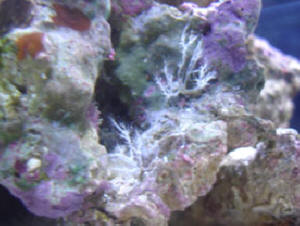 
|
| Bryozoans? - 09/06/06 Hi Folks,
<<Jan>> As usual, thanks so much for the great service
that you provide!! You & your website have become
an indispensable component in my efforts to create a happy &
balanced tank. <<We're pleased you find the site
useful>> This stuff (see attached photo) has started growing
in my tank, which is a new tank (since May 2006). I have
no idea what it is. <<Mmm, the picture could be a bit
closer...is difficult to discern...>> Can you help? <<I
have three guesses here Jan...this looks to be either a species of
hydroid, in which case you may want to take action to remove...or,
more likely I suspect, a species of Bryozoan, in which case you can
sit back and enjoy while they last...and my last guess would be a
species of sponge, also no reason for concern>> Thanks,
Jan <<Quite welcome. EricR>>
<My guess is with Eric's. Likely Bryozoan colonies.
RMF> |
|
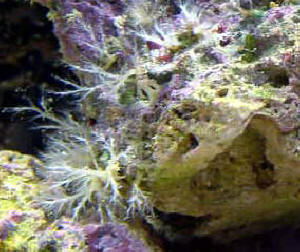
|
Cleaning Bryozoan skeletons 9/1/06 Hello
WetWebMedia Crew, <Adam> Firstly, I've read through your
articles on cleaning coral skeletons and have a good idea of what to do
but I still have a few questions. I recently collected some dead
calcareous Bryozoan skeletons from the beach which had been washed up
after a storm and I would like to clean them and use them as decoration
in my seahorse tank. They were definitely dead but there was still some
organic material from where they had been attached to seagrass rhizomes
as well as dead sponges, ascidians etc attached to them which I picked
out with a pair of tweezers. <Good> I soaked them for two days in
clean fresh water, then boiled them and they are now sitting on a wire
rack in the sun. I was a worried about using bleach because of their
very porous nature and thought that it might be difficult to ensure
that all the bleach was completely washed away. <Not so much an
issue as the conjugate acid nature of bleaches... dissolving these
calcium carbonate based skeletons...> They still smell very strongly
of rotten sea life, will this go away after they have been left to
bleach in the sun? <Possibly not for quite a long time...> Also,
some of the pieces are a very attractively coloured in a deep purple
colour, will the sun destroy this and if so would placing them under
shade to dry out be ok? <Mmm, won't likely result in their being
"cleaned"> Is there anything else I should do to make sure
that it is safe to place in the aquarium? <I would
"experiment" with dilute bleach (sodium hypochlorite)
solution (either that used for clothing/washing or the pool/spa
industry), with different dilutions... and rinse/soak for a day after
exposure, change the water out (for all new/fresh) and dose with a
"dechlorinator" (or make your own...) a few concentrations
more than directions... let soak another day... This should do it...
though you can/could test for free chlorine still present...> Here
is a link to a photo of the type of thing am dealing with.
http://bio.fsu.edu/~bsc2011l/bryzoan_images_sum_04/Calcareous-bryozoan.jpg
Yours Sincerely Adam Harbeck <Bob Fenner>
Photo use Mr. Fenner, <Judy (yes am that old to repeat
your name a few more times, sigh> The Shawnee County Conservation
District respectfully requests permission to use the Bryozoan,
Iodictyum sp. photo from the Wet Web Media web site. We are
making a display of fossils with pictures of the actual animal when it
was alive (or something close with what they look like
now.) May we please use the attached photo? <You may
indeed. Please make it known if you folks want a different format,
resolution, re-scan. Thank you for your efforts. Bob Fenner> Thank
you, Judy Boltman District Manager Shawnee County Conservation District
Topeka, KS
Bryozoa Down the Drain Hello, I have a question I hope you
can help me with. Bryozoa is fast becoming a problem at water and
wastewater treatment facilities across the USA. I know there are some
species that are freshwater only, but are you aware of any studies or
projects on the effects of the saltwater hobby and byproducts of us
cleaning our aquariums and flushing it down the drain? <Mmm,
interesting. Bryozoans, Aschelminths period are a rarity in our
interest. Most all perish in the rigors of collection of the hard
substrates they colonize> I work for a municipality in the metro
Phoenix area and have witnessed an outbreak of Bryozoa in the last 5 to
10 years that was not present before that. Are there any species which
might live in both fresh and salt water? I cannot help but believe we
may be a part of the problem. Thank you, A.J. <Not as far as I'm
aware. Wouldn't take much to find out. Here's my pitch on doing
literature searches: http://www.wetwebmedia.com/litsrchart.htm
Get thee to a large (college) library! Bob Fenner>
Re: Bryozoa Thanks for the response Bob. A group of
wastewater professionals are meeting in the Phoenix area next month to
discuss Bryozoa and other treatment challenges and we are hoping some
of the legwork may already be done and available to us. <Me too. Ah,
reminds me of happy meetings with friends in organizations like the
"Aquatic Plant Management Society"... a great mix of
"old-timer" scientists, technicians, folks who
"did" the work... very enjoyable and great learning, sharing
experiences> Love your new book and really enjoyed meeting you and
Anthony at our Desert Marine Society meeting. <Ahh! Now I
remember!> Can't wait until the others in the series come out.
Any idea on the release dates? <Perhaps a year in-between each...
Poor Anthony going over my poor initial drafts, my poring through his
verbose re-writes (he actually has an advanced degree in
literature!?)... then poor Christine doing the layouts!!! Sheesh,
amazing they get done at all. Thank you for asking. Bob Fenner>
Thanks,
A.J.
| Bryozoan Algae? Hi guys- I have
an opportunity to obtain a red Bryozoan. I have seen a photo of it
and it kind of looks like a Fauchea Sp. (Dark red macro algae). How
would you tell them apart? <Upon close examination (just with
your eyes, no scope) you will notice that bryozoans are much more
"stiff" than what you have shown here... which looks like
a red algae> I was on your Bryozoan page but the photos
don't show up. It said I need a username and password from
Tuskfish. wetwebfotos.com. Attached are photos of it. I am buying
it from someone from another state and will not be able to actually
see it in person. What should I ask in order to confirm its
identity? If it is a Bryozoan, what would you recommend regarding
care - feeding, placement, water flow, etc.? Thanx, Tim <Please
see here re bryozoans: http://www.wetwebmedia.com/bryozoans.htm
elsewhere on WetWebMedia.com re Fauchea. Bob Fenner> |
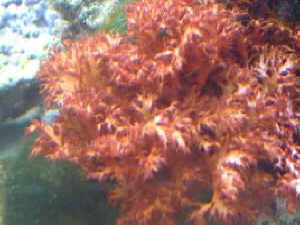 |
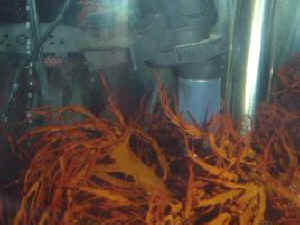 |
Bryozoan care Also, what about the bryozoans? Do they need
any special care? Are they photosynthetic? Thanks! <Check here
(toward the bottom of the page) and beyond: http://www.wetwebmedia.com/marine/inverts/.
Also found boo-koo hits on www.google.com. Don
|
|

